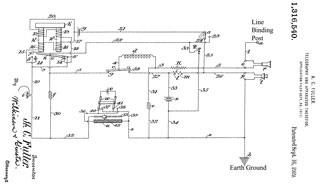 |
 |
|
|
|
 |
 |
|
handset with 4 prong plug |
|
 |
 |
|
|
|
 |
 |
|
handset with 4 prong plug |
|
The Fullerphone is a way to send Morse code using either a pair of wires or a single wire and an Earth ground path. It is very hard to pick up using any other kind of equipment and can be superimposed on a normal telephone circuit without interaction.
The U.S. Signal Corps TG-5-() is a version of this system that came out in the 1930s. It uses an interupter made from an earphone with a carbon contact and operates at about 1 kHz.
This is a D.C. telegraph system that was a predecessor to field phones. In the battery box on the left went 2 square and tall 1.5 V wet cell batteries. There are 4 separate wires going to the two cells because they serve different purposes. The Chopper (buzzer) on the right slides out. It's marked BUZZER "F" MK II*, YA4139, E. and the three contacts are marked +, _, C. Photo a my pair with No.9 phone plugs.
The first Fullerphones were Morse only, but the Tele Set D Mk 5 combined a normal field phone and a Fullerphone into one unit.
The top label says:TELEPHONE SET. D. MK.V
P.E.W. Ltd
SER. No. C 3579
1940The handset uses a 4 prong plug to connect to the main unit. The switch is marked "Press Key While Speaking Tele HD No 2".
The battery box in the rear center looks like it holds 3 each of the same square and tall wet cells as were used on the Mark IV. The circuit diagram in the lid shows two cells in a series connection with no tap in the center.
 |
1316540 Telegraphy and Apparatus therefor, Algernon Clement Fuller, Sept. 16, 1919 |
Fullerphone, Various models and constructional details, Using the Fullerphone - Louis Meulstee's web site Wire Less For the Warrior- Article in OTB - Mk IV photo -
Back to Brooke's Products
for
Sale,
Telephone,
Military
Information,
Home page
This is the [an error occurred while processing this directive] time this page has been accessed since since 8 Aug. 2002.